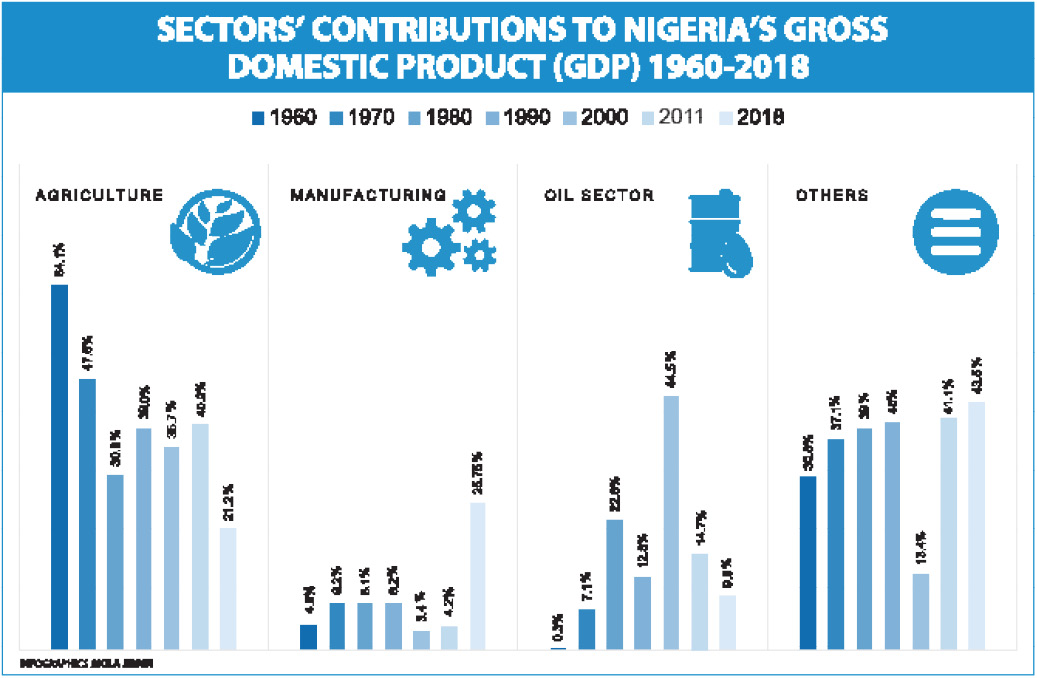Nigeria’s recovery‘ll take years amid structural defects of economy
Economic and policy experts have advised the Nigerian government to adopt far-reaching proactive economic policy measures as strategic options towards averting a prolonged national economic crisis in view of the existing policy gaps and lopsided structure of the nation’s economy over the decades. Experts, who hinged their concerns on two fundamental grounds, namely the inadequacy […]

Economic and policy experts have advised the Nigerian government to adopt far-reaching proactive economic policy measures as strategic options towards averting a prolonged national economic crisis in view of the existing policy gaps and lopsided structure of the nation’s economy over the decades.
Experts, who hinged their concerns on two fundamental grounds, namely the inadequacy of the existing development policies to cope with shocks and graft-supportive and dysfunctional institutions in the public sector, have cautioned that if government failed to act fast, the nation’s current poverty, unemployment and insecurity rates may aggravate and plunge it into prolonged social, economic and political crises.
Available statistics sourced by Daily Trust from the Central Bank of Nigeria’s (CBN) reports and other research works showed that in 1960, Agriculture contributed 64.1% to the nation’s GDP compared to the Manufacturing sector’s 4.8% and other sectors’ 30.8 percent contributions. The Oil sector only accounted for 0.3% of the GDP then.
Twenty years later (1980), Agriculture still maintained its lead, contributing 30.8% to the GDP, while Manufacturing and Other Sectors contributed 8.1% and 39.1% respectively. During the fiscal year, the Oil sector contributed 22.8%.
A further analysis of the various sectors’ contributions to the nation’s GDP in 2011 showed that Agriculture, Manufacturing, Oil, Other sectors still held sway, contributing 40.0%, 4.2%, 14.7% and 41.1% respectively.
By 2018, the narrative had not changed as the Oil sector accounted for about 8.56% of the GDP rate while Agriculture, Manufacturing and Other sectors contributed 21.2%, 25.75% and 52.0% to the GDP.
Apart from the non-oil sector, the nation’s Health Sector has suffered prolonged neglect for decades both in terms of budgetary allocations and implementation of primary and secondary healthcare systems such that today, Nigeria is rated among nations with high mortality rates and susceptibility to health risks such as the present COVID-19 pandemic, Lassa fever and malnutrition, amongst others.
More statistical data from the public finance agencies and researchers showed that between 1999 and 2016, the federal government spent over N52.67 trillion in yearly budgets compared to the states’ N55.36 trillion, yet the nation’s health sector lacks critical technology, infrastructure and well-motivated personnel to make service delivery to the sick efficient.
These developments are not in line with the expectations of the Nigerian authorities if the provisions in the Quarantine Act (CAP Q2, LFN 2004), the National Health Act (2014) and several other public health legislations at federal and state levels are to be used as assessment parameters for the responsiveness of the Nigerian government to the COVID-19 pandemic.
Sadly, today it is estimated that about 2,300 under-five-year-olds and 145 women of child-bearing age die in Nigeria daily while neonatal mortality rate of about 37 per 1000 people translates to an estimated 25,000 yearly.
Ironically, successive governments have failed to tackle this and as experts have noted, the leadership ineptitude to efficiently manage the resources and their egocentric approaches to governance at all levels have today turned Nigeria into ‘the poverty headquarters of the world’.
For instance, the nation’s unemployment rate report as published by the NBS in December 2018 indicated that in Q3, 2018, the economically active or working age population rose from 111.1 million in Q3,2017 to 115.5 million in the corresponding quarter of 2018. Out of the figure, in Q3, 2017, 18.8 percent of the population was unemployed, a percentage that further rose to 23.1 in Q3, 2018.
